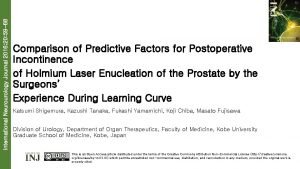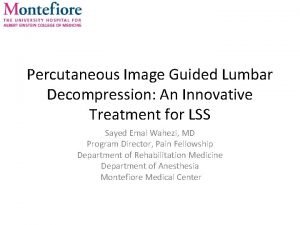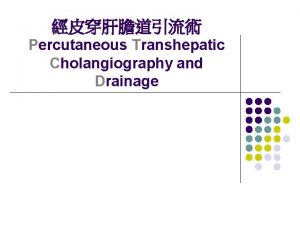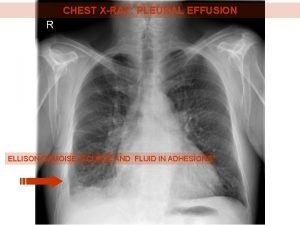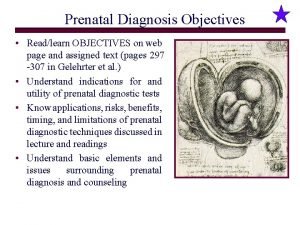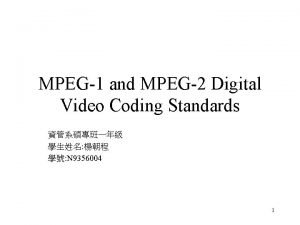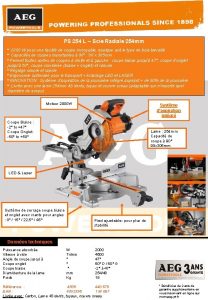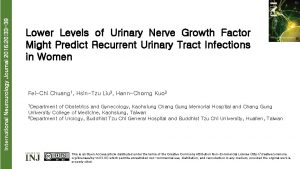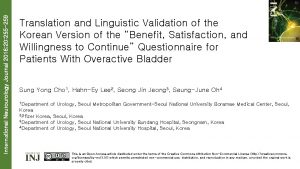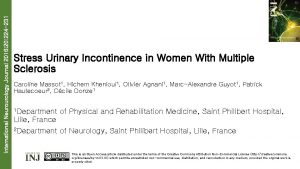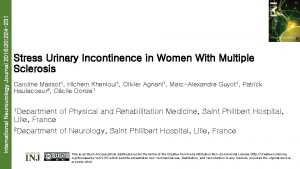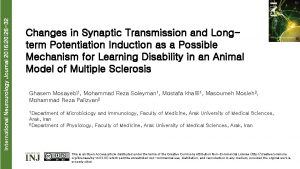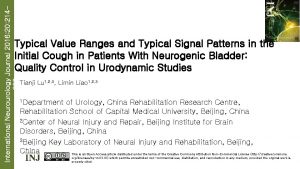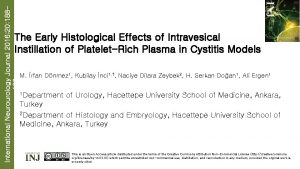International Neurourology Journal 2016 20 250 254 Percutaneous












- Slides: 12

International Neurourology Journal 2016; 20: 250 -254 Percutaneous Nerve Evaluation Test Versus Staged Test Trials for Sacral Neuromodulation: Sensitivity, Specificity, and Predictive Values of Each Technique Mai Banakhar 1, Magdy Hassouna 2 1 King Abdulaziz University, Faculty of Medicine, Jeddah, Saudi Arabia 2 University of Toronto, University Health Network, Toronto Western Hospital, Toronto, Canada This is an Open Access article distributed under the terms of the Creative Commons Attribution Non-Commercial License (http: //creativecommons. org/licenses/by-nc/3. 0/) which permits unrestricted non-commercial use, distribution, and reproduction in any medium, provided the original work is properly cited.

International Neurourology Journal 2016; 20: 250 -254 INTRODUCTION • Inter. Stim device is an U. S. Food and Drug Administration approved minimal invasive therapy for sacral neuromodulation for lower urinary tract dysfunction. • Before Inter. Stim implantation, a trial with the appropriate screening tests is required to determine patient therapy eligibility. There are two different techniques for patient screening: percutaneous nerve evaluation (PNE) test and staged test. • However, test sensitivity and predictive values of either test have not been studied. The aim of our study was to determine the sensitivity and specificity of each test and to establish a decision algorithm for the most appropriate testing method to be used as a screening test.

International Neurourology Journal 2016; 20: 250 -254 MATERIALS AND METHODS • This cross-sectional study was conducted from August 2009 to February 2012 and included patients with lower urinary tract dysfunction who participated in the stimulation test trial. • Patients underwent PNE as the first stimulation test, while those who encountered technical difficulty during PNE or electrode migration underwent staged testing.

International Neurourology Journal 2016; 20: 250 -254 RESULTS • A total of 213 patients, including 172 female and 41 male subjects, underwent PNE. The patients’ diagnoses included refractory overactive bladder (47. 9%), nonobstructive urinary retention (29. 6%), and frequency urgency syndrome (22. 1%). • A total of 202 patients were screened with PNE and 10 patients with staged testing. • Overall sensitivity of PNE was 87. 3%, and it was 90% for staged test. PNE specificity was 98. 5% as compared to 92. 9% for staged test. Positive and negative predictive values for PNE were 99% and 82. 1% and for staged test were 90% and 92. 9%, respectively. CONCLUSIONS • PNE test has high specificity and positive predictive value. We recommend PNE, a simple office-based, less expensive procedure as the first option for screening.

International Neurourology Journal 2016; 20: 250 -254 Table 1. Patients demographic

International Neurourology Journal 2016; 20: 250 -254 Table 2. Primary analysis of sensitivity and specificity for PNE test versus staged test trial

International Neurourology Journal 2016; 20: 250 -254 Table 3. Pearson correlation between primary analysis result and patient’s age, sex, and diagnosis

International Neurourology Journal 2016; 20: 250 -254 Table 4. Sensitivity, specificity for PNE test versus staged test trial in refractory overactive bladder

International Neurourology Journal 2016; 20: 250 -254 Table 5. Sensitivity, specificity for PNE test versus staged test trial in chronic retention

International Neurourology Journal 2016; 20: 250 -254 Table 6. Sensitivity, specificity for PNE test versus staged test trial in frequency- urgency syndrome, pelvic pain

International Neurourology Journal 2016; 20: 250 -254

International Neurourology Journal 2016; 20: 250 -254 Fig. 1. Decision algorithm for selection of test trial. PNE, percutaneous nerve evaluation. Inter. Stim (Medtronic Inc. , Minneapolis, MN, USA).
 International neurourology journal
International neurourology journal Percutaneous image-guided lumbar decompression (pild)
Percutaneous image-guided lumbar decompression (pild) Percutaneous transhepatic cholangiography and drainage
Percutaneous transhepatic cholangiography and drainage Percutaneous balloon pericardiotomy
Percutaneous balloon pericardiotomy Ellis curve radiology
Ellis curve radiology Choledocholithiasis
Choledocholithiasis Amnio vs cvs
Amnio vs cvs Article paru dans le journal le monde en 2016
Article paru dans le journal le monde en 2016 Do 254 specification
Do 254 specification Round 271 to the nearest hundred
Round 271 to the nearest hundred 0 254
0 254 Do 254 users group
Do 254 users group 455 en yakın onluk ve yüzlüğe yuvarlama
455 en yakın onluk ve yüzlüğe yuvarlama
